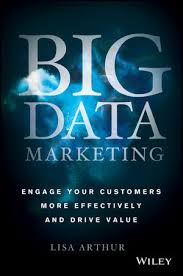 I’ve been promoting the concept of Computational Marketing for some time here on insideBIGDATA and elsewhere because it is quite clear that modern marketing is nothing without data. So it’s great to see a new book aligned with this notion – Big Data Marketing by Lisa Arthur.
I’ve been promoting the concept of Computational Marketing for some time here on insideBIGDATA and elsewhere because it is quite clear that modern marketing is nothing without data. So it’s great to see a new book aligned with this notion – Big Data Marketing by Lisa Arthur.
The data driven movement is marching forward at a steady pace, and the world before data already seems to be a very foreign place. Arthur calls the before times “Dark Ages of business.” What she achieves in this new big data title is not only the creation of an informative roadmap to help marketing professionals make the most of their data assets, but also an intriguing collection of stories, studies, and personal anecdotes to energize data driven marketers in their endeavors.
The author introduced her “Dark Ages of business” concept as a “pandemonium of different agendas and perceptions” in the corporate C-suite. She effectively asserts early in the book that data ignorance in a marketing setting is not a good strategic position in which to find yourself. Arthur reports some key statistics including -58% of marketers report high confidence in data driven approaches, 82% of data savvy marketers have improved market share with data driven insights, and 78% of marketers have expectations of being more data driven. Arthur makes a clear case throughout the book that data driven marketing is a new necessity not a luxury.
One consistent theme in the book is Arthur’s concept of the “data hairball,” which she describes this way:
The complicated mess of interactions, applications, data, and processes that accumulate unchecked when companies are unprepared to handle information from a wide range of sources.”
The hairball analogy achieves its purpose – to make readers cringe at a potentially undesirable problem. This problem arises when companies believe more data means more value. Arthur counters this viewpoint with, “more data does not equal the right data, and data alone does not equal insight.” With the “data hairball” image, Arthur emphasizes the importance of establishing an effective supply of the right data before ramping up the demand for more data. Of course data scientists know that to improve the predictive power of machine learning algorithms, more data (i.e. the right data) is paramount.
Though her notion of “Dark Ages of business” serves as a sobering reminder of life before big data, Arthur also maps out a hopeful vision for the future with what she calls the “Enlightened Age of Data.” With validation from analyst firm Gartner’s estimate that by 2017, CMOs will outspend CIOs on technology purchases, the book paints a picture of a time when marketing will drive revenue with scientific efficacy fueled by big data analytics. This is really what Computational Marketing is all about and the book carries this note well. Fortunately, Arthur complements this potentially idealistic future with accounts of what data driven marketers are presently doing to get there. The book includes examples from Arthur’s own initiatives at Teradata centered around key measures for demonstrating the contribution marketing has on the company’s bottom line.
Big Data Marketing sets the stage for important Computational Marketing initiatives and is a must-read for all marketers for 2014 and beyond. While Arthur’s guidance on leveraging data alone makes the book worthwhile, it’s her ability to provide actionable guidance for this highly technical sphere of marketing that makes the book accessible and valuable for all readers.




Speak Your Mind